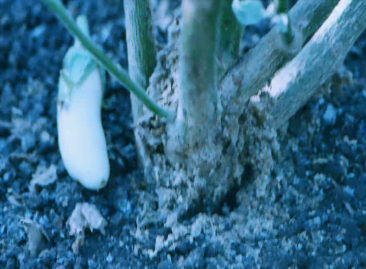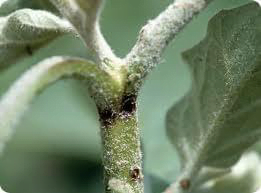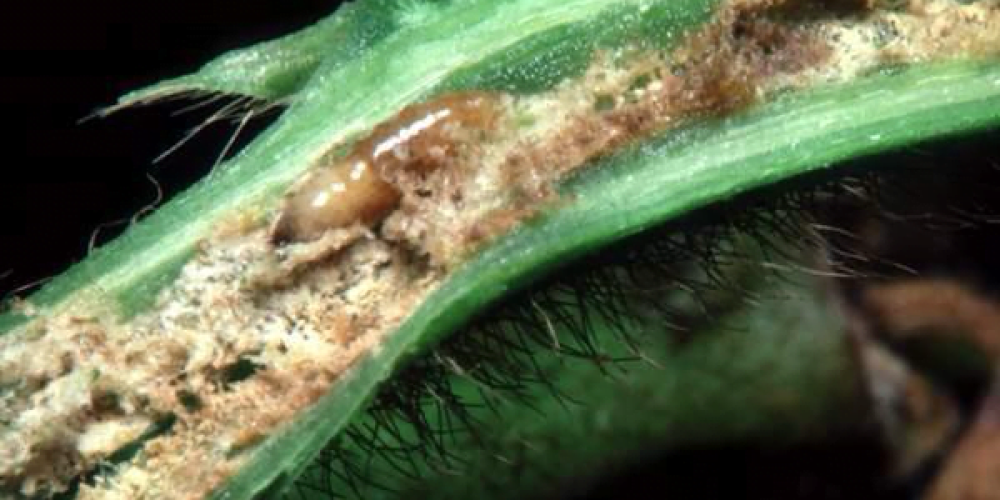Table of contents of the article
Toggle
The eggplant stem borer is a serious pest that harms the eggplant crop. In this article on your website, WORLD OF PLANTS, we discuss effective control methods.
Symptoms of eggplant stem borer infestation
- The infection begins from April to May on grapevine.
- The insect begins to appear in permanent soil in June on eggplant and continues until the end of the eggplant season.
- The insect larvae feed by digging into the stem of the plant, where the leaves of the affected branch turn yellow, including all the leaves (similar to an iron deficiency). Continuing feeding by the larvae leads to the drying of the affected plant branch as a result of the lack of water and nutrients reaching the affected branch.
- The larvae excrete the product of the larvae’s excavations mixed with the insect’s feces, which is sawdust for nutrition.
- The larvae on the soil surface. •
- When potato tubers are present, the larvae dig a superficial tunnel in the tuber.
- Families: – Potato, eggplant, tobacco, and green pepper.
Morphological description of the eggplant stem borer insect
- The adult insect is a yellowish-brown butterfly. The color of the front wings is yellowish-brown. There is a dark spot in the middle of each wing. On the outer edge there are two zigzag lines. The distance between the front wings when they are open is 10-12 mm. The color of the back wings is white and has yellow veins. The length of the butterfly ranges between six and eight millimeters.
- The larvae have 5 instars, and in the fifth instar their color is yellowish white, the color of the head and first thorax is brown, and its length is 14-15 mm.
- The pupa is located inside a white silk cocoon about 10.4 mm long.
Symptoms of infestation and damage by the eggplant stem borer
The eggplant stem borer is a serious pest that harms the eggplant crop. In this article on your website, WORLD OF PLANTS, we discuss effective control methods.
Life cycle of the eggplant stem borer
- The insect spends the winter hibernation as a fully-developed larva in a silk cocoon inside the affected stem or among plant debris.
- In the spring, the insect becomes active again, and the larvae turn into pupae within the cocoons. Adults appear in May, and the fertilized females behave like laying solitary eggs on the stem of the affected plant. The embryonic development period ranges from five to seven days.
- The duration of larval development ranges from five to six weeks.
- The fully-grown larva cannot fit into the tunnel it digs, and the pupal stage takes two to three weeks. The adult insect repeats the life cycle, as the insect has five generations per year.

Controlling the eggplant stem borer insect
- Remove plant residues and exclude infected tubers.
- Chemical control is directed against adults and during egg laying to eliminate newly hatched larvae, before they enter the stem.
- You can use one of the following pesticides: Anthio-Lipacid and other modern pesticides.
- Getting rid of weeds, especially grape weeds, so that they are not a source of infection.
- Periodic examination to identify the presence of the insect by examining the stems weekly and noting the presence of the larvae’s feeding products.
- Since this pest hibernates in the stems of plants, the remains of the previous crop must be disposed of by burning as soon as the plants are finished.
- Eliminate the larvae inside the plant tunnel using a flexible wire. 5
- Completely infected plants are removed and burned to kill the larvae present in them.
- Control is carried out preventively, as it is beneficial to use pesticides used on other eggplant pests that may eliminate the larvae in their early ages. Control can be done by injecting a pesticide into the infestation tunnel to kill the larvae in the infected plant.
In conclusion, we would like to note that we, at the world of plants website, offer you all the necessary services in the world of plants, we provide all farmers and those interested in plants with three main services::-
- Artificial intelligence consulting service to help you identify diseases that affect plants and how to deal with them.
- Blog about plants, plant diseases and care of various crops ... You are currently browsing one of her articles right now.
- An application that provides agricultural consultations to clients, as well as a service for imaging diseases and knowing their treatment for free – Click to download the Android version from Google Play Store، Click to download the IOS version from the Apple App Store.
Sources:
Eggplant pests...a researcher explains the most prominent ones and methods of biological and chemical control - Misr Agricultural Channel
Eggplant stemporer – almerja




